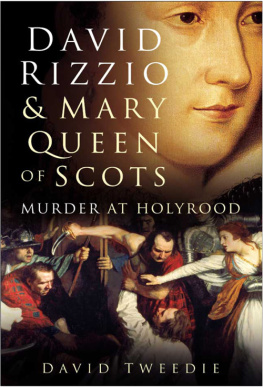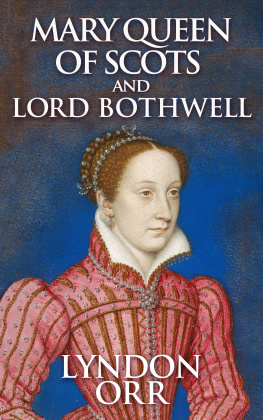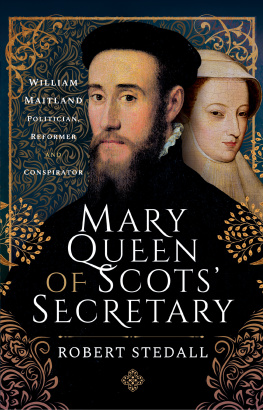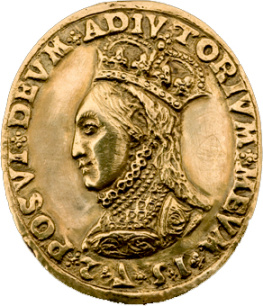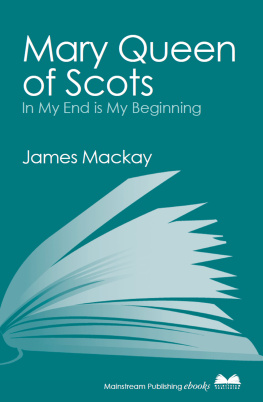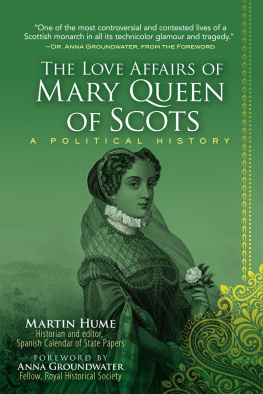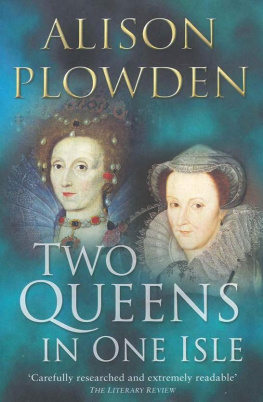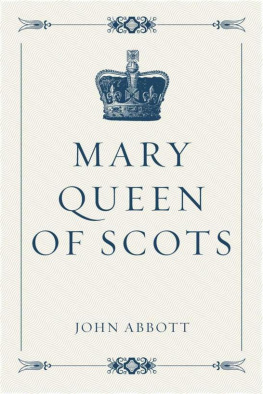David Rizzio
and Mary
Queen of Scots
David Rizzio
and Mary
Queen of Scots
Murder at Holyrood
D AVID T WEEDIE
THE HISTORY PRESS
First published in 2006 This revised edition 2007
The History Press
The Mill, Brimscombe Port
Stroud, Gloucestershire, GL 5 2 QG
www.thehistorypress.co.uk
This ebook edition first published in 2011
All rights reserved
David Tweedie, 2006, 2007, 2011
The right of David Tweedie, to be identified as the Author of this work has been asserted in accordance with the Copyrights, Designs and Patents Act 1988.
This ebook is copyright material and must not be copied, reproduced, transferred, distributed, leased, licensed or publicly performed or used in any way except as specifically permitted in writing by the publishers, as allowed under the terms and conditions under which it was purchased or as strictly permitted by applicable copyright law. Any unauthorised distribution or use of this text may be a direct infringement of the authors and publishers rights, and those responsible may be liable in law accordingly.
EPUB ISBN 978 0 7524 7081 8
MOBI ISBN 978 0 7524 7082 5
Original typesetting by The History Press
Contents
Note on the Text
S pelling and orthography have changed since the sixteenth century. John Knox, for example, referred to duck when he meant duke. Here modern punctuation and capitalisation are provided, and the language updated, so as to make sense to the reader today. Some specific Scots words for example, thole, policies will also be found. But the quotations keep to the original language as much as possible, especially in Marys letters.
The New Year is assumed to begin on 1 January, and not on 25 March (Lady Day, the Feast of The Annunciation) and dates are given accordingly.
Any errors are the fault of the author, for which he begs indulgence.
Prologue
F or over 200 years an enormous smoky, black, bitumen-based oil painting has hung in the Guildhall at the heart of the old City of London. This dark canvas depicts the murder of David Rizzio in gory Gothic detail. It shows Patrick, Lord Ruthven, wasted with cancer and cased in body armour, holding back the anguished figure of Mary Queen of Scots, as his henchmen ready themselves to stab their prey to death.
Since the picture was first hung in 1793, statesmen, aldermen, monarchs and national heroes, when enjoying the Citys hospitality, have lifted their eyes from the turtle soup and liverymens fare to ponder this work by John Opie. Only two generations ago the Soviet Foreign Minister, Mr Gromyko, cracked a rare joke when he saw the painting, after the then British Prime Minister, Sir Alec Douglas Home, had told him that he was descended from Rizzios murderers. It must have reminded him of life back home under Marshal Stalin.
This is the story of the victim in that picture.
David Rizzio was Italian. He arrived in Edinburgh in December 1561, where he rose to an influential position at the cosmopolitan Renaissance court of Queen Mary. He became her secretary, her chief minister, so that for a brief moment they ruled the country together, much to the irritation of the English government.
His ascendancy was at its zenith between the autumn of 1565 and the spring of 1566. An intelligent and personable adventurer, he offered a programme of religious toleration at home and friendship with the leading powers abroad. Ill-wishers said that the Queen became his mistress. It was also rumoured that he was to be appointed Lord Chancellor and be given a large estate south of Edinburgh. He certainly lived as a rich man in the style of a great Florentine prince like Cosimo de Medici.
Yet his regime could not last. The Queen and her minister had made too many powerful enemies. His sense of fun and love of music may have helped him charm his way to the top. But he was too exotic for prim bourgeois Edinburgh, and sadly his quips and jokes failed to work on the newly Protestant Scots, who were just grimly concerned for the security of their religion. Soon the militant Protestants and disaffected barons combined together to revolt against his rule.
On the evening of 9 March 1566 the storm broke. A party of malcontents, led by Ruthven and backed up by at least eighty of his Douglas clansmen, forced their way into the palace of Holyroodhouse, overcame the protests of the gatekeepers and brutally slaughtered the Italian secretary while he was sitting at supper with the Queen. Sauvez moi madame, sauvez ma vie! Justizia, Justizia was his pathetic cry just before he met his end, in his strange mixture of French and Italian.
The attack took place with the acquiescence and in the presence of Marys jealous, but hopelessly inadequate, husband, Henry Stewart, the Lord Darnley. The conspirators then proceeded to hold her captive. This was an atrocity performed for a political purpose but dressed up as a crime passionel. It was also an act of masculine aggression against a defenceless female, symbolised by the grey steel of Ruthvens dagger pressed to Marys womb as she tried to shield her terrified retainer. She was then six months pregnant by Darnley, or, as some said, by Rizzio, and the risk of miscarriage was high. The impact of his death that cold spring night still resonates. It is at least arguable that, if he had been given more time to consolidate his power and if Mary had shown some of the hard-headed realism of her Cousin and Good sister, Queen Elizabeth of England, Scotland might today still be an independent state of nominal Catholic faith.
This book explains why Rizzio so enraged the Scots lords that they planned his murder with such zest. It points to the complicity of Elizabeth and her leading ministers in the conspiracy to do away with him, and it tells why the Reformed congregations around Europe exulted when they heard of the killing, since with him died the possibility of religious counter-reformation.
But much of his life is still a mystery. He was killed in his prime, before he could pen any justification for his work. There are few papers and little surviving correspondence to illuminate his real personality and policies, which must all be pieced together from what shadowy evidence is available.
The Queen escaped the assassins and took shelter with her ally and future lover, James, Earl of Bothwell, in his castle by the coast. Soon she was able to return to her capital in triumph and plot her revenge. She sent an express messenger to her old friend and spiritual adviser, James Beaton, the absentee Archbishop of Glasgow, who was away in exile in Paris, with a detailed account of the murder.
Rizzio was an attractive older man with a masterful personality, and perhaps became something of a father figure to Mary. Were they really lovers, or maybe he was gay? She certainly liked his company, and found his conversation witty and charming, while his sunny Latin jokes and pleasantries reminded her of happy childhood days by the Loire. And political business often brought them together. His position as her secretary required constant close contact, which inevitably gave rise to yet more gossip and speculation.
In council he argued his case forcibly, and his views counted. A vivid description exists of him debating policy there in his deep and eloquent bass voice. He argued with Mary like a spouse, and, it was reported, sometimes he reproved her more sharply than her own husband would do.1 If true, this was a fault on his part, which sensible prime ministers in later ages have wisely avoided. It is hard to imagine Disraeli addressing Queen Victoria like a hectoring husband.
The rumour that Mary took him as her lover was, of course, sensational. It did no good to her reputation then, and maybe still damages it today. It soon spread like wildfire throughout the Protestant community, who enjoyed exaggerating the reputation of the Scottish Queen for sexual promiscuity, and whose behaviour could be contrasted with her chaste cousin, Elizabeth, the Virgin Queen. The reports soon reached the English ambassador in Edinburgh, and lost nothing in the telling. As early as October he had alluded to the reasons for Marys new hostility to her older brother, which was because he understandeth some such secret part (not to be named for reverence sake) that standeth not well with her honour, which he so much detesteth being her brother.2

